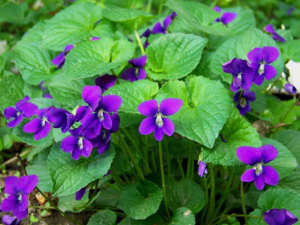Violet (common blue violet)
Viola sororia
Summary:
Common blue violet, or Viola sororia, is a perennial plant native to North America. It thrives in woodlands and meadows, offering both ornamental and medicinal benefits. Known for its heart-shaped leaves and vibrant purple flowers, violets are often cultivated in gardens or found growing wild, even in yards. They have a rich history in folk medicine and are edible in various forms.
You might need violet if . . .
- You suffer from respiratory issues like coughs and colds
- You need to soothe skin irritation or inflammation
- You are looking for a mild, natural remedy for stress
Benefits of Violet . . .
- Respiratory health: Violets have been traditionally used to treat coughs, colds, and bronchitis due to their soothing properties on the respiratory system.
- Skin health: The plant is often used topically to soothe skin irritations, such as eczema or acne.
- Anti-inflammatory: Violet has anti-inflammatory properties that can help reduce swelling or irritation.
- Antioxidants: Violet flowers contain antioxidants that may support overall health and wellness.
- Calming effect: Some people use violets for their gentle sedative effects to reduce anxiety and stress.
Common ways to use Violets
- Tea: Violet leaves and flowers can be brewed into a mild, soothing tea.
- Infused oil: Violet flowers can be infused into oil to make topical skin treatments for burns and irritations.
- Edible in salad: The fresh leaves and flowers can be eaten raw in salads and used as a lovely garnish.
- Tincture: Violet tinctures are commonly used for respiratory and skin-related ailments.
- Violet Jelly: Violet petals can be made into a fragrant, beautiful jelly, with a light floral flavor, perfect for spreading on toast or adding to desserts.
- Violet color-changing lemonade: Violet flowers can be used to create a color-changing lemonade that kids love. When the flowers are steeped in water, their natural anthocyanin pigment reacts with the acidity of lemon juice, changing the color from purple to pink! – natural pink lemonade!
Growing and Foraging Information
Violets are a very common plant to forage. They are frequently found in yards and woodland areas, often growing as wildflowers or intentionally planted for their beauty and benefits. Their vibrant purple flowers are not only a delightful sight but also a great opportunity to engage children in foraging activities. Teach kids to gently pick the flowers, emphasizing the importance of not overharvesting and leaving some behind for pollinators. Violets are easy to identify with their heart-shaped leaves and distinct purple flowers (although you may occasionally find them in white and yellow varieties, still edible, making them perfect for outdoor educational activities with kids.
| Scientific Name | Viola sororia |
| Common Name | Common Violet |
| Hardiness Zones | 3 – 9 |
| Soil Type | Well-drained and moist |
| Sun Exposure | Prefers partial shade but will tolerate full sun in cooler climates |
| Watering | Keep soil moist but not soggy |
| Planting | Plant in early spring or fall |
| Height | Can get to about 6 inches |
| Harvest | You can harvest the leaves and flowers in late spring and in some areas throughout the beginning of summer. |
| Pests and Diseases | Generally resistant – slugs and aphids occasionally |
Safety Concerns
Drug Interaction: If you have any health concerns or are taking any prescription medication, please consult with your health care provider before adding new herbs to your diet.
Breastfeeding and Pregnancy: There are no known contraindications for breastfeeding and pregnancy.
Other Concerns: Violets are generally safe for all, but be cautious and try a small amount the first time to see how it affects you.







